JEEP RENEGADE 2015 1.G Owners Manual
Manufacturer: JEEP, Model Year: 2015, Model line: RENEGADE, Model: JEEP RENEGADE 2015 1.GPages: 678, PDF Size: 29.84 MB
Page 311 of 678
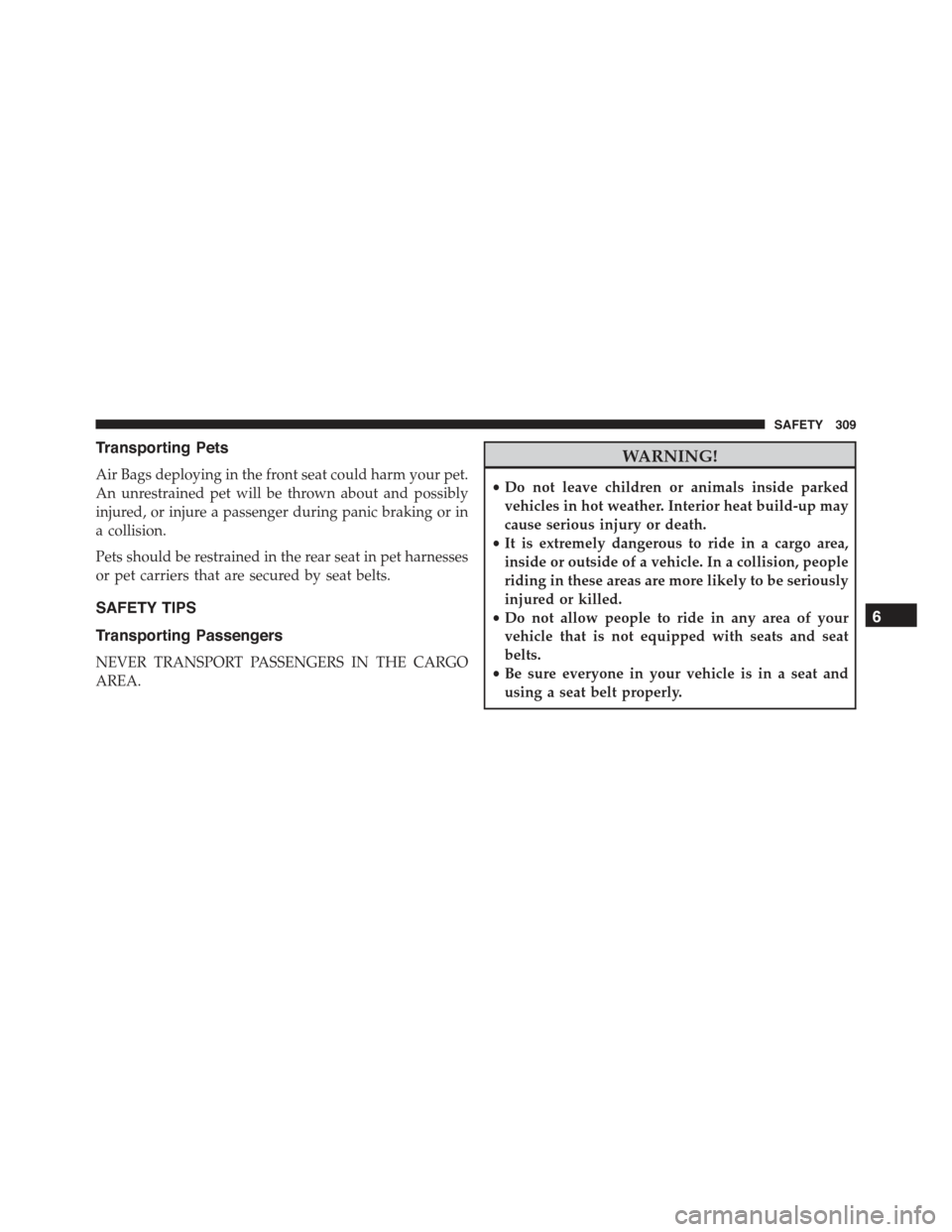
Transporting Pets
Air Bags deploying in the front seat could harm your pet.
An unrestrained pet will be thrown about and possibly
injured, or injure a passenger during panic braking or in
a collision.
Pets should be restrained in the rear seat in pet harnesses
or pet carriers that are secured by seat belts.
SAFETY TIPS
Transporting Passengers
NEVER TRANSPORT PASSENGERS IN THE CARGO
AREA.
WARNING!
•Do not leave children or animals inside parked
vehicles in hot weather. Interior heat build-up may
cause serious injury or death.
•It is extremely dangerous to ride in a cargo area,
inside or outside of a vehicle. In a collision, people
riding in these areas are more likely to be seriously
injured or killed.
•Do not allow people to ride in any area of your
vehicle that is not equipped with seats and seat
belts.
•Be sure everyone in your vehicle is in a seat and
using a seat belt properly.
6
SAFETY 309
Page 312 of 678
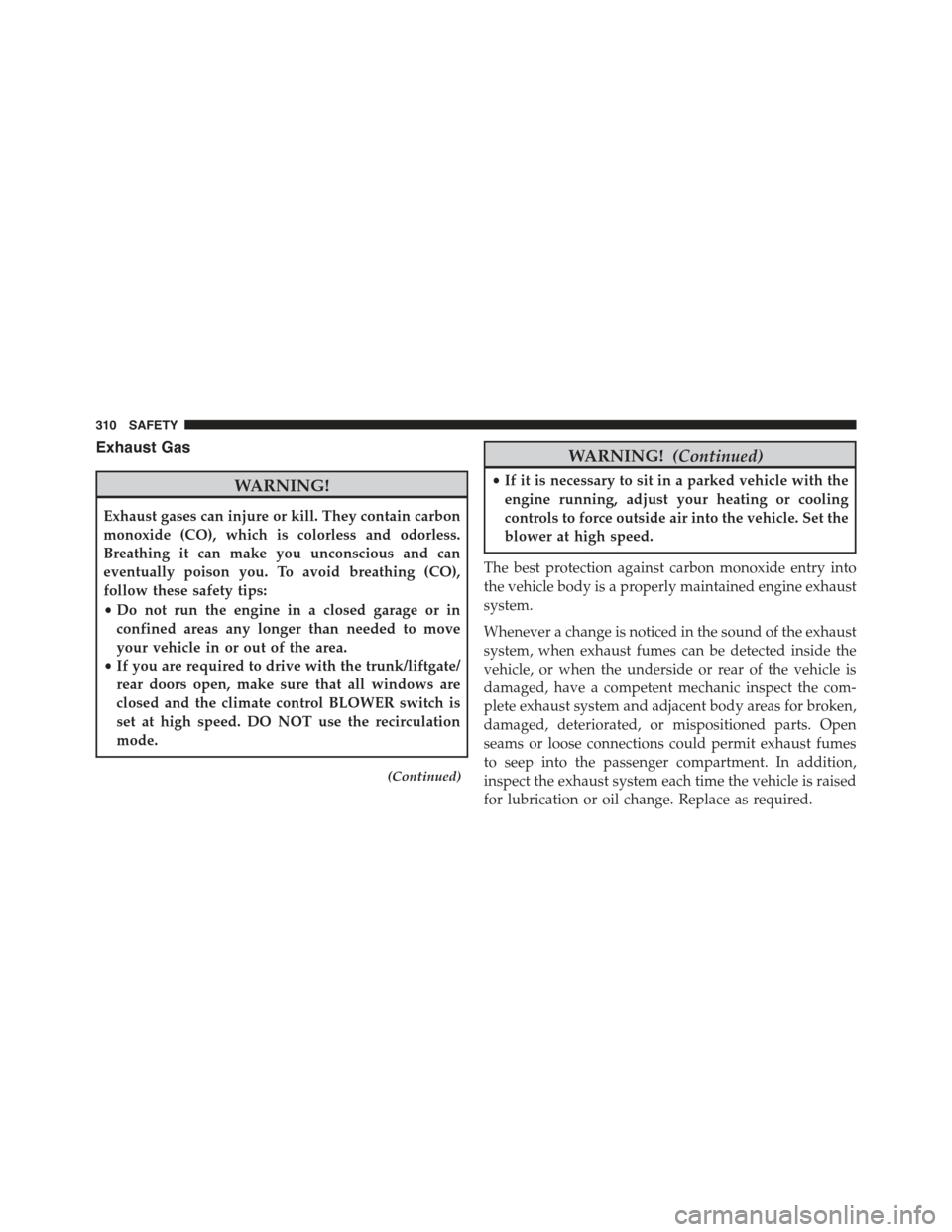
Exhaust Gas
WARNING!
Exhaust gases can injure or kill. They contain carbon
monoxide (CO), which is colorless and odorless.
Breathing it can make you unconscious and can
eventually poison you. To avoid breathing (CO),
follow these safety tips:
•Do not run the engine in a closed garage or in
confined areas any longer than needed to move
your vehicle in or out of the area.
•If you are required to drive with the trunk/liftgate/
rear doors open, make sure that all windows are
closed and the climate control BLOWER switch is
set at high speed. DO NOT use the recirculation
mode.
(Continued)
WARNING!(Continued)
•If it is necessary to sit in a parked vehicle with the
engine running, adjust your heating or cooling
controls to force outside air into the vehicle. Set the
blower at high speed.
The best protection against carbon monoxide entry into
the vehicle body is a properly maintained engine exhaust
system.
Whenever a change is noticed in the sound of the exhaust
system, when exhaust fumes can be detected inside the
vehicle, or when the underside or rear of the vehicle is
damaged, have a competent mechanic inspect the com-
plete exhaust system and adjacent body areas for broken,
damaged, deteriorated, or mispositioned parts. Open
seams or loose connections could permit exhaust fumes
to seep into the passenger compartment. In addition,
inspect the exhaust system each time the vehicle is raised
for lubrication or oil change. Replace as required.
310 SAFETY
Page 313 of 678
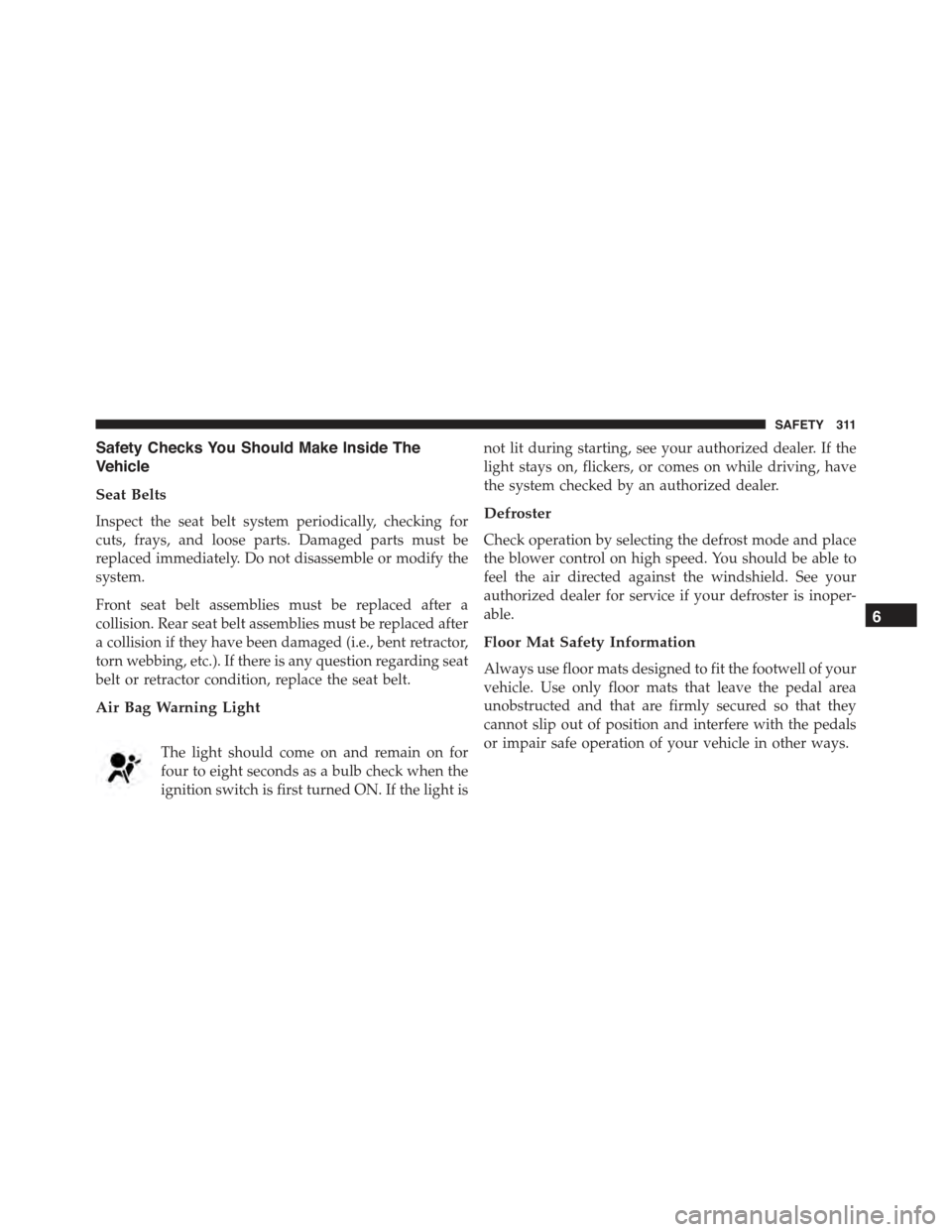
Safety Checks You Should Make Inside The
Vehicle
Seat Belts
Inspect the seat belt system periodically, checking for
cuts, frays, and loose parts. Damaged parts must be
replaced immediately. Do not disassemble or modify the
system.
Front seat belt assemblies must be replaced after a
collision. Rear seat belt assemblies must be replaced after
a collision if they have been damaged (i.e., bent retractor,
torn webbing, etc.). If there is any question regarding seat
belt or retractor condition, replace the seat belt.
Air Bag Warning Light
The light should come on and remain on for
four to eight seconds as a bulb check when the
ignition switch is first turned ON. If the light is
not lit during starting, see your authorized dealer. If the
light stays on, flickers, or comes on while driving, have
the system checked by an authorized dealer.
Defroster
Check operation by selecting the defrost mode and place
the blower control on high speed. You should be able to
feel the air directed against the windshield. See your
authorized dealer for service if your defroster is inoper-
able.
Floor Mat Safety Information
Always use floor mats designed to fit the footwell of your
vehicle. Use only floor mats that leave the pedal area
unobstructed and that are firmly secured so that they
cannot slip out of position and interfere with the pedals
or impair safe operation of your vehicle in other ways.
6
SAFETY 311
Page 314 of 678
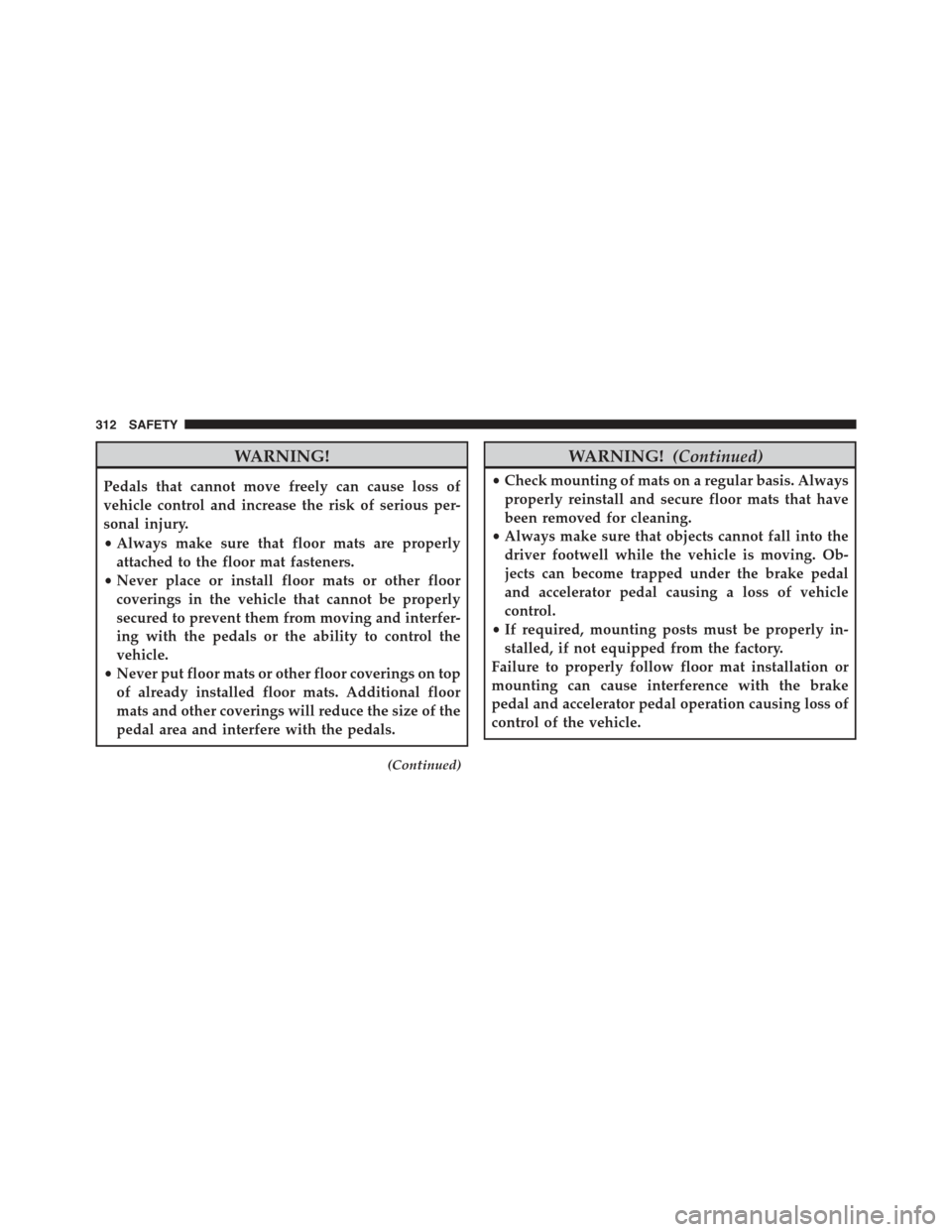
WARNING!
Pedals that cannot move freely can cause loss of
vehicle control and increase the risk of serious per-
sonal injury.
•Always make sure that floor mats are properly
attached to the floor mat fasteners.
•Never place or install floor mats or other floor
coverings in the vehicle that cannot be properly
secured to prevent them from moving and interfer-
ing with the pedals or the ability to control the
vehicle.
•Never put floor mats or other floor coverings on top
of already installed floor mats. Additional floor
mats and other coverings will reduce the size of the
pedal area and interfere with the pedals.
(Continued)
WARNING!(Continued)
•Check mounting of mats on a regular basis. Always
properly reinstall and secure floor mats that have
been removed for cleaning.
•Always make sure that objects cannot fall into the
driver footwell while the vehicle is moving. Ob-
jects can become trapped under the brake pedal
and accelerator pedal causing a loss of vehicle
control.
•If required, mounting posts must be properly in-
stalled, if not equipped from the factory.
Failure to properly follow floor mat installation or
mounting can cause interference with the brake
pedal and accelerator pedal operation causing loss of
control of the vehicle.
312 SAFETY
Page 315 of 678
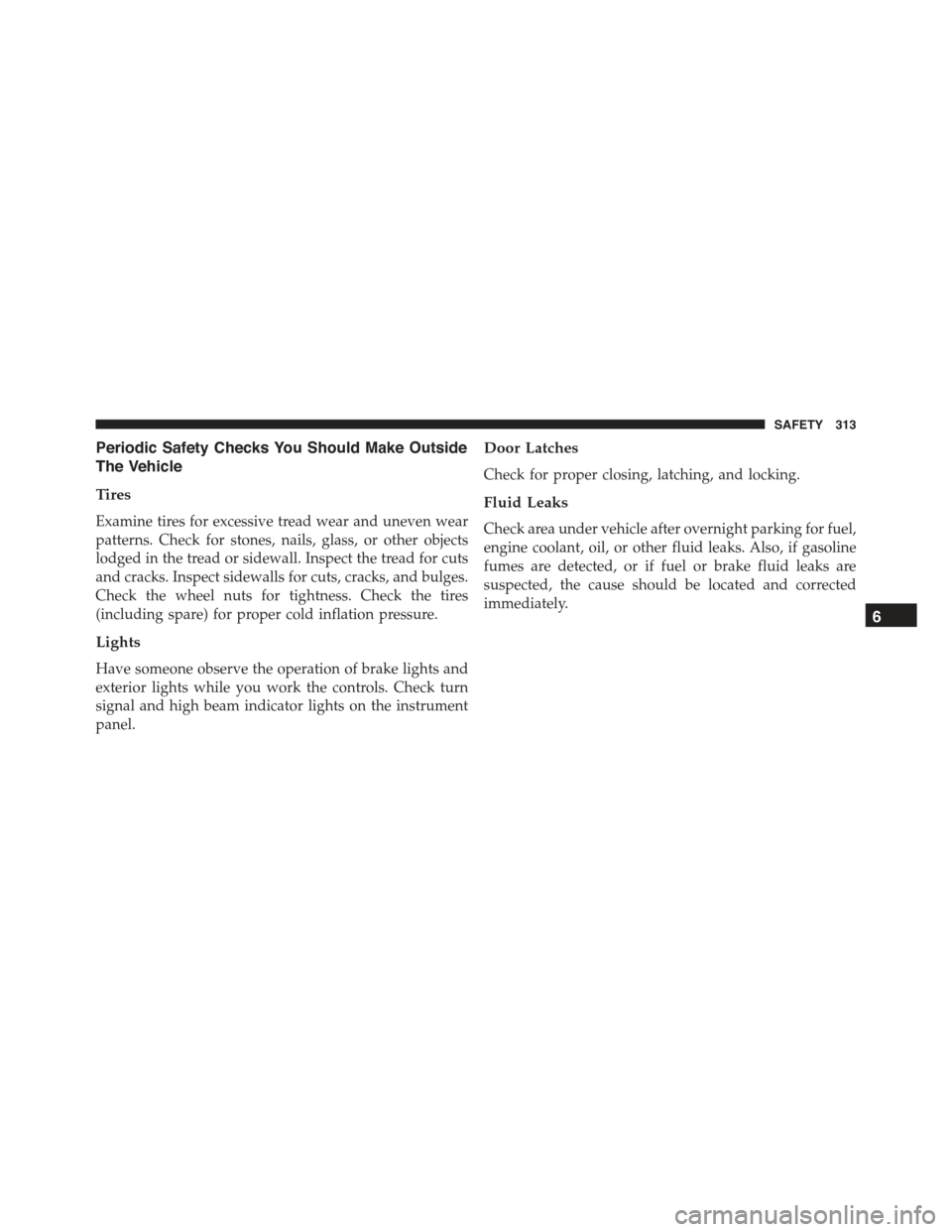
Periodic Safety Checks You Should Make Outside
The Vehicle
Tires
Examine tires for excessive tread wear and uneven wear
patterns. Check for stones, nails, glass, or other objects
lodged in the tread or sidewall. Inspect the tread for cuts
and cracks. Inspect sidewalls for cuts, cracks, and bulges.
Check the wheel nuts for tightness. Check the tires
(including spare) for proper cold inflation pressure.
Lights
Have someone observe the operation of brake lights and
exterior lights while you work the controls. Check turn
signal and high beam indicator lights on the instrument
panel.
Door Latches
Check for proper closing, latching, and locking.
Fluid Leaks
Check area under vehicle after overnight parking for fuel,
engine coolant, oil, or other fluid leaks. Also, if gasoline
fumes are detected, or if fuel or brake fluid leaks are
suspected, the cause should be located and corrected
immediately.6
SAFETY 313
Page 316 of 678

Page 317 of 678
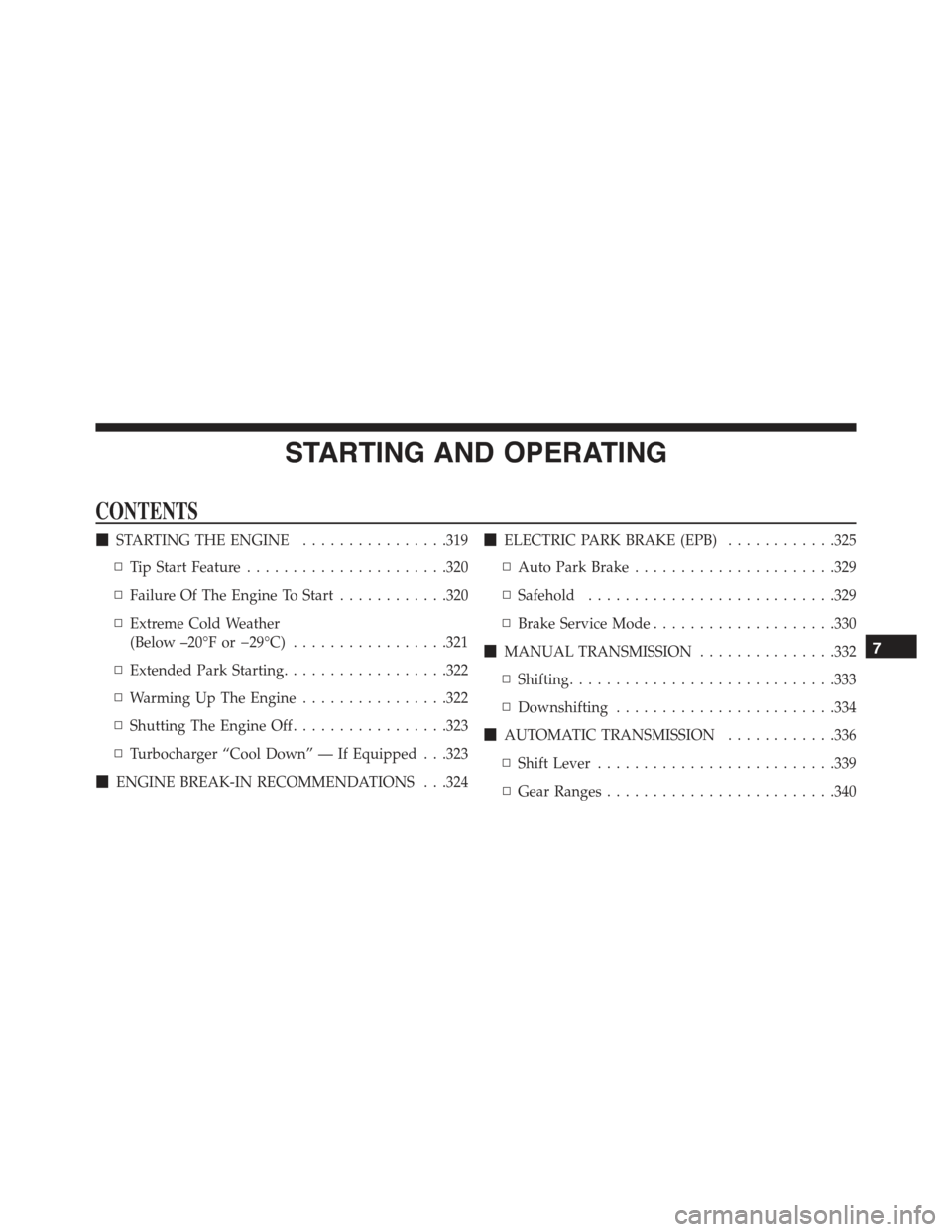
STARTING AND OPERATING
CONTENTS
!STARTING THE ENGINE................319
▫Tip Start Feature......................320
▫Failure Of The Engine To Start............320
▫Extreme Cold Weather
(Below –20°F or−29°C).................321
▫Extended Park Starting..................322
▫Warming Up The Engine................322
▫Shutting The Engine Off.................323
▫Turbocharger “Cool Down” — If Equipped . . .323
!ENGINE BREAK-IN RECOMMENDATIONS . . .324
!ELECTRIC PARK BRAKE (EPB)............325
▫Auto Park Brake......................329
▫Safehold...........................329
▫Brake Service Mode....................330
!MANUAL TRANSMISSION...............332
▫Shifting.............................333
▫Downshifting........................334
!AUTOMATIC TRANSMISSION............336
▫Shift Lever..........................339
▫Gear Ranges.........................340
7
Page 318 of 678
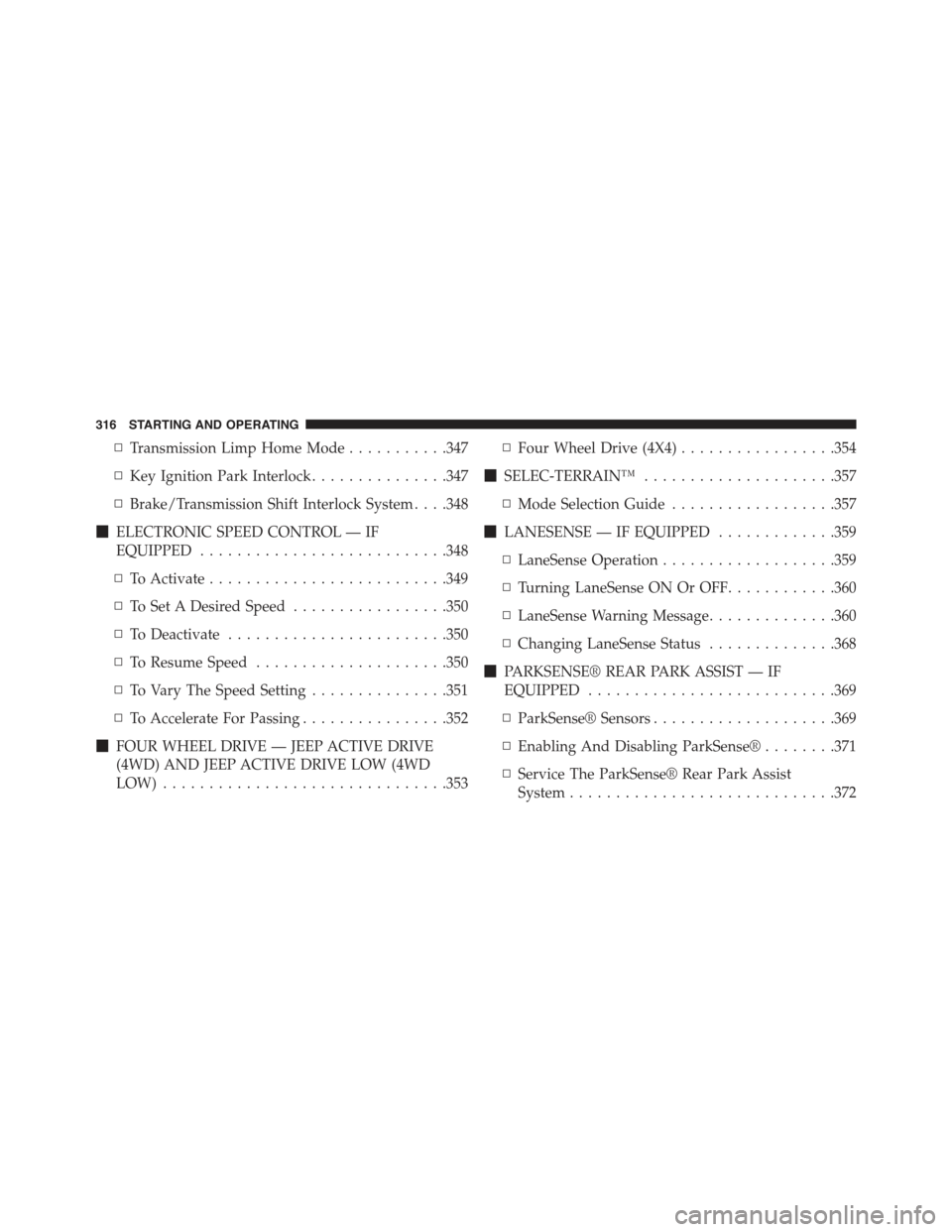
▫Transmission Limp Home Mode...........347
▫Key Ignition Park Interlock...............347
▫Brake/Transmission Shift Interlock System . . . .348
!ELECTRONIC SPEED CONTROL — IF
EQUIPPED...........................348
▫To Activate..........................349
▫To Set A Desired Speed.................350
▫To Deactivate........................350
▫To Resume Speed.....................350
▫To Vary The Speed Setting...............351
▫To Accelerate For Passing................352
!FOUR WHEEL DRIVE — JEEP ACTIVE DRIVE
(4WD) AND JEEP ACTIVE DRIVE LOW (4WD
LOW)...............................353
▫Four Wheel Drive (4X4).................354
!SELEC-TERRAIN™.....................357
▫Mode Selection Guide..................357
!LANESENSE — IF EQUIPPED.............359
▫LaneSense Operation...................359
▫Turning LaneSense ON Or OFF............360
▫LaneSense Warning Message..............360
▫Changing LaneSense Status..............368
!PARKSENSE® REAR PARK ASSIST — IF
EQUIPPED...........................369
▫ParkSense® Sensors....................369
▫Enabling And Disabling ParkSense®........371
▫Service The ParkSense® Rear Park Assist
System.............................372
316 STARTING AND OPERATING
Page 319 of 678
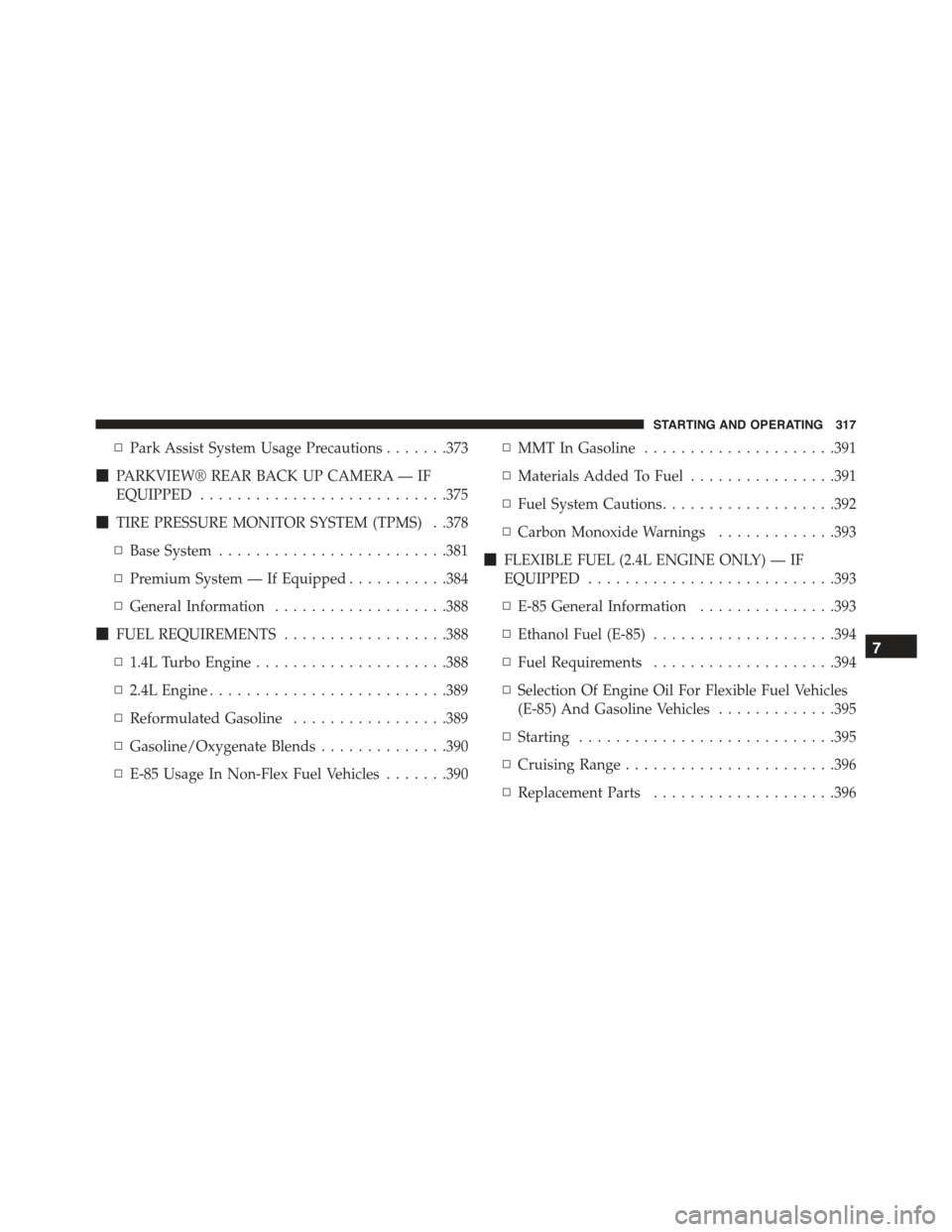
▫Park Assist System Usage Precautions.......373
!PARKVIEW® REAR BACK UP CAMERA — IF
EQUIPPED...........................375
!TIRE PRESSURE MONITOR SYSTEM (TPMS) . .378
▫Base System.........................381
▫Premium System — If Equipped...........384
▫General Information...................388
!FUEL REQUIREMENTS..................388
▫1.4L Turbo Engine.....................388
▫2.4L Engine..........................389
▫Reformulated Gasoline.................389
▫Gasoline/Oxygenate Blends..............390
▫E-85 Usage In Non-Flex Fuel Vehicles.......390
▫MMT In Gasoline.....................391
▫Materials Added To Fuel................391
▫Fuel System Cautions...................392
▫Carbon Monoxide Warnings.............393
!FLEXIBLE FUEL (2.4L ENGINE ONLY) — IF
EQUIPPED...........................393
▫E-85 General Information...............393
▫Ethanol Fuel (E-85)....................394
▫Fuel Requirements....................394
▫Selection Of Engine Oil For Flexible Fuel Vehicles
(E-85) And Gasoline Vehicles.............395
▫Starting............................395
▫Cruising Range.......................396
▫Replacement Parts....................396
7
STARTING AND OPERATING 317
Page 320 of 678
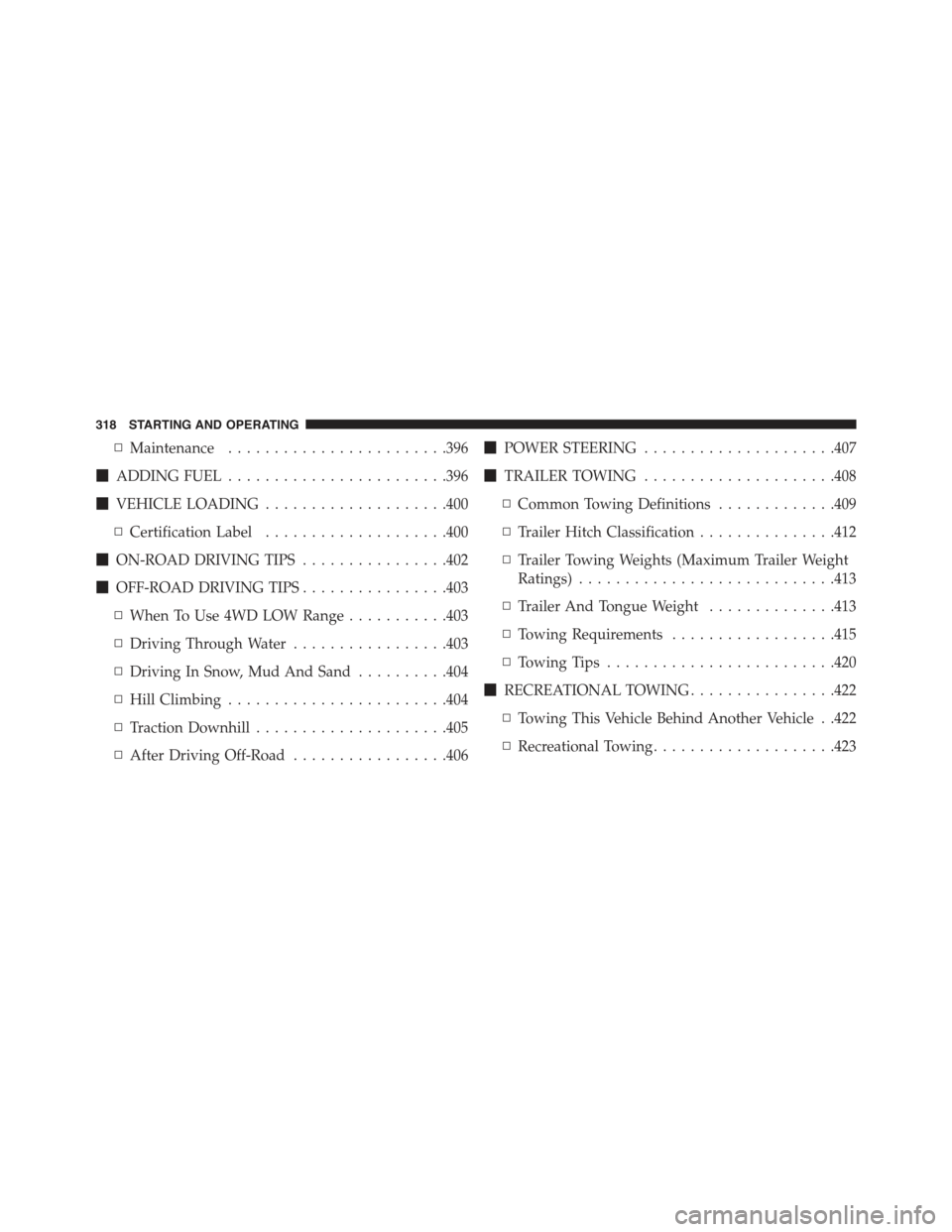
▫Maintenance........................396
!ADDING FUEL........................396
!VEHICLE LOADING....................400
▫Certification Label....................400
!ON-ROAD DRIVING TIPS................402
!OFF-ROAD DRIVING TIPS................403
▫When To Use 4WD LOW Range...........403
▫Driving Through Water.................403
▫Driving In Snow, Mud And Sand..........404
▫Hill Climbing........................404
▫Traction Downhill.....................405
▫After Driving Off-Road.................406
!POWER STEERING.....................407
!TRAILER TOWING.....................408
▫Common Towing Definitions.............409
▫Trailer Hitch Classification...............412
▫Trailer Towing Weights (Maximum Trailer Weight
Ratings)............................413
▫Trailer And Tongue Weight..............413
▫Towing Requirements..................415
▫Towing Tips.........................420
!RECREATIONAL TOWING................422
▫Towing This Vehicle Behind Another Vehicle . .422
▫Recreational Towing....................423
318 STARTING AND OPERATING